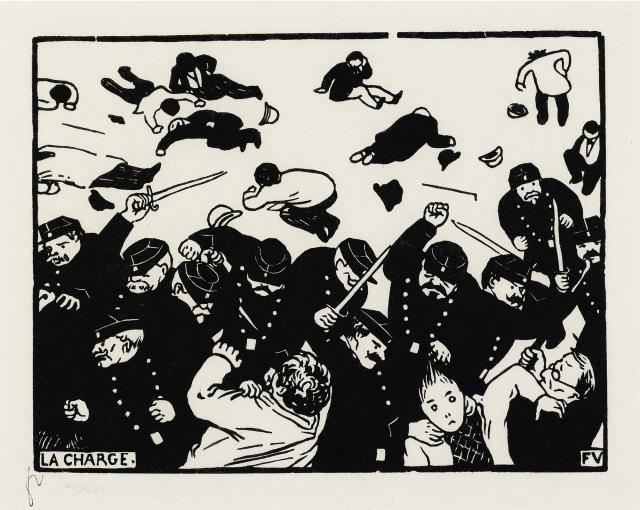For a period of ten years – from 1891 to 1901 – Félix Vallotton will focus almost exclusively on printmaking, which contributes greatly to his international renown. For the most part, his woodcuts illustrate Parisian life in the 1890s, which he describes with verve and humour. Vallotton is daring in his compositions and creates highly simplified motifs to achieve striking effects, always in black and white. Close to the experiments of the French avant garde – postimpressionism, Art nouveau, the Nabis – he eliminates nuanced shadows and excess detail in favour of concise forms and sharp contrasts.
Vallotton sketches the daily dramas of existence, from the political and social to the personal. Between 1892 and 1896, numerous street scenes took shape. La Charge (The Charge, Collection Pictet) bears witness to the frequent social unrest roiling Paris in the 1890s. Within a tightly framed image where only the presence of the human figures constructs a three-dimensional space, the foreground offers a view of a compact crowd of policemen. The dark black mass of human beings stands out against the spotless roadway. This graphic contrast heightens the opposition between the protesters and the police. Every aspect of the print adds to the sense of crushing weight and repression. In both the choice of the subject here and its depiction, the viewer can readily make out Vallotton’s political commitment and anarchist sympathies.
In the series of prints called Les Intimités (Intimate Moments), he observes love relations with a disillusioned eye. Couples in eloquent attitudes are shown in bourgeois interiors that are constructed like theatre sets where cruelty, deceit, hypocrisy and ridicule play out. In L’Éclat (The Blaze, Collection Pictet), Vallotton captures a furtive moment of tension between lovers. A man, with knitted brow and stern look, confronts his consort with a no doubt compromising letter. The highly simplified yet incisive shapes help to create an uncomfortable atmosphere.
Finally, the Alpine landscape is also one of the major themes developed by Vallotton in his wood engraving. Cervin, Breithorn, Le Glacier du Rhône (The Rhône glacier) and Mont-Blanc (Collection Pictet) are part of a series of six engravings dating from 1892 that depict Swiss mountains. The influence of Japanese prints is notable here. With remarkable economy, he creates a strong visual ambience and manages to bring to life a mass of snow melting beneath a black sun that is nonetheless shining with light.
Vallotton sketches the daily dramas of existence, from the political and social to the personal. Between 1892 and 1896, numerous street scenes took shape. La Charge (The Charge, Collection Pictet) bears witness to the frequent social unrest roiling Paris in the 1890s. Within a tightly framed image where only the presence of the human figures constructs a three-dimensional space, the foreground offers a view of a compact crowd of policemen. The dark black mass of human beings stands out against the spotless roadway. This graphic contrast heightens the opposition between the protesters and the police. Every aspect of the print adds to the sense of crushing weight and repression. In both the choice of the subject here and its depiction, the viewer can readily make out Vallotton’s political commitment and anarchist sympathies.
In the series of prints called Les Intimités (Intimate Moments), he observes love relations with a disillusioned eye. Couples in eloquent attitudes are shown in bourgeois interiors that are constructed like theatre sets where cruelty, deceit, hypocrisy and ridicule play out. In L’Éclat (The Blaze, Collection Pictet), Vallotton captures a furtive moment of tension between lovers. A man, with knitted brow and stern look, confronts his consort with a no doubt compromising letter. The highly simplified yet incisive shapes help to create an uncomfortable atmosphere.
Finally, the Alpine landscape is also one of the major themes developed by Vallotton in his wood engraving. Cervin, Breithorn, Le Glacier du Rhône (The Rhône glacier) and Mont-Blanc (Collection Pictet) are part of a series of six engravings dating from 1892 that depict Swiss mountains. The influence of Japanese prints is notable here. With remarkable economy, he creates a strong visual ambience and manages to bring to life a mass of snow melting beneath a black sun that is nonetheless shining with light.
